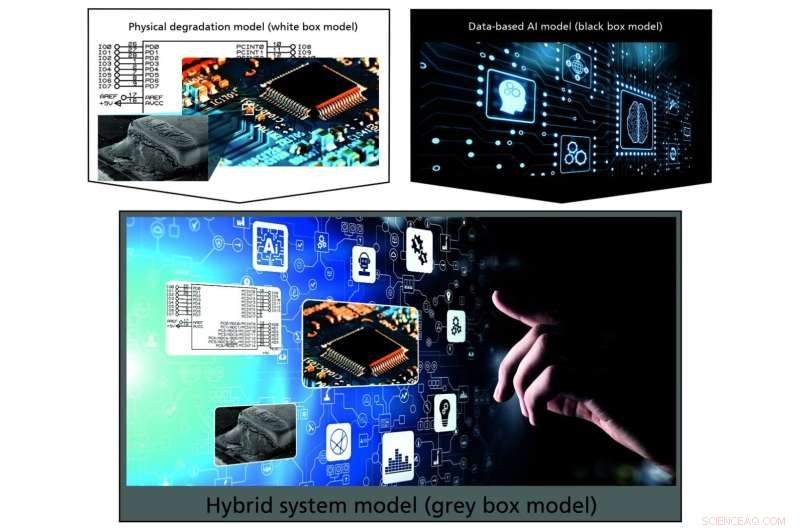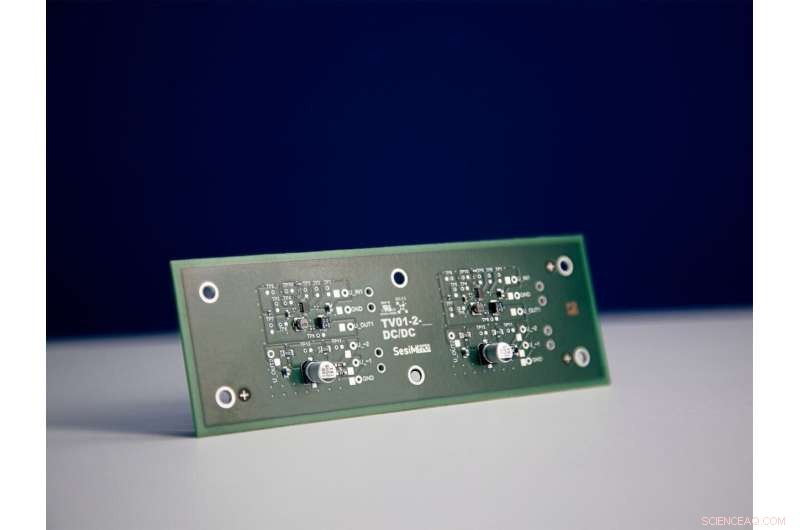
Los modelos híbridos combinan las ventajas de los modelos físicos y basados en datos. Crédito:Fraunhofer IZM
Cuando mezclas blanco y negro, obtienes gris, y con él, un nuevo método que debería permitir que los sistemas electrónicos complejos se monitoreen a sí mismos. Usando los llamados modelos de caja gris, en los que están trabajando los investigadores del Instituto Fraunhofer de Fiabilidad y Microintegración IZM, será posible detectar signos de desgaste o manipulación en los sistemas electrónicos en una etapa temprana, antes de que ocurra una falla real.
El nuevo proceso se está desarrollando y probando inicialmente para aplicaciones críticas para la seguridad en los sectores automotriz y ferroviario. Sin embargo, el principio básico se puede transferir a muchas más áreas de aplicación.
Se espera que un automóvil funcione de manera confiable durante muchos años, durante veranos calurosos, inviernos helados, lluvia y tormentas. Hoy, sin embargo, nuestros vehículos están equipados con cada vez más dispositivos electrónicos que deben poder soportar estas condiciones extremas.
Hasta ahora, este problema de los sistemas críticos para la seguridad a menudo se ha resuelto en la práctica con un diseño excesivo y funciones redundantes. Un ejemplo de ello son los sistemas electrónicos o partes de los mismos que se instalan por duplicado, de modo que cuando ocurre una falla, el sistema de respaldo puede tomar el control hasta que se solucione el problema.
Un proyecto de investigación en Fraunhofer IZM está contribuyendo a un futuro de soluciones más elegantes, sostenibles y energéticamente eficientes en esta área. Como parte del proyecto SesiM, que comenzó el verano pasado bajo el liderazgo de Siemens AG, los investigadores de Fraunhofer están trabajando junto con otros socios de los campos de la movilidad y la inteligencia artificial para encontrar soluciones de autovalidación para sistemas electrónicos complejos.
Centrándose en aplicaciones automotrices y ferroviarias, los investigadores están investigando cómo estos sistemas podrían evaluarse a sí mismos e informar sobre su estado, por ejemplo, a través de un sistema de iluminación integrado.
"Estamos más interesados en el estado antes de que se rompan los componentes electrónicos que cuando realmente están rotos", explica el Dr. Johannes Jaeschke, ingeniero eléctrico y líder del proyecto Fraunhofer IZM para el proyecto conjunto.
"Mucho antes de que un sistema falle, ciertas funciones pueden verse comprometidas, por ejemplo, cuando los materiales se vuelven quebradizos. La estabilidad mecánica del componente a menudo no proporciona una detección lo suficientemente temprana de los signos de envejecimiento. Esto dificulta la supervisión de los sistemas electrónicos".
Hacer gris a partir de blanco y negro
Los investigadores del proyecto consideran que el modelo de caja gris es la clave para la autovalidación eficaz de los sistemas electrónicos. Ha adquirido este nombre porque se basa tanto en enfoques de caja blanca como de caja negra.
Durante muchos años, Fraunhofer IZM ha estado trabajando intensamente en sistemas electrónicos a nivel físico. Con su experiencia en tecnología de medición y diseño, los investigadores pueden desarrollar modelos para el monitoreo y pronóstico de condiciones basados en procesos físicos y modelados, por ejemplo, en torno a condiciones límite como la temperatura o la humedad.
Because it is clear how this type of model functions, it is called a white box model. However, the more complex an electronic system is, the harder it is to map and monitor it on a purely physical level in a holistic manner. For data-driven models that use artificial intelligence, complex structures and large amounts of data are no problem. However, what happens inside these systems remains unclear—hence the name black box model.
"We can combine the best of both worlds in gray box models," summarizes Jaeschke. "This is why we are also referring to it as hybrid modeling. We can process a vast amount of data while, at the same time, understanding the physical reasons behind changes in the signal. This way, we can increase trust in our data."

Test PCB with functional structures for generating a digital fingerprint. Credit:Fraunhofer IZM
From test printed circuit boards (PCBs) to prototypes
To date, practical applications of gray box models are largely unchartered territory. So, after an initial design phase, the SesiM researchers are now also working on describing simple circuits that will increase in complexity as the research project progresses. The test PCBs are precisely measured and tested during production and then in their operating state.
"By doing this, we are generating a digital fingerprint for our test wiring," explains Jaeschke. This means that data will be collected even under extreme boundary conditions.
The next step is to identify the parameters within the large amount of data that are relevant for mapping the system and then, taking into account the physical knowledge, to create a model that detects deviations from a predefined ideal state. External manipulations should thereby be recognized as quickly as possible, and wear can be forecast early on.
At a later point in the project, the test PCBs will then be transferred to prototypes for automotive and rail applications, which will be used to extensively analyze the models created.
Potential for a range of applications
In the future, it may therefore be possible for an integrated intelligent system in a car to provide an early warning for a problem with the electronics, offering a self-diagnosis. When servicing a car, mechanics will then be able to view all of the information collected by the vehicle about its condition and make targeted repairs on the basis of this information.
A follow-up project by researchers at Fraunhofer IZM will focus on the topic of aviation. Applications outside of the mobility sector are also possible—for example in medical engineering and offshore windfarms, for which regular external monitoring and preventative maintenance are difficult to carry out.
The overarching aim of SesiM is to initially prove that the basic principle that electronic systems can self-validate using gray box models actually holds true.
Jaeschke has faith in the idea:"If we succeed, our approach will make a significant contribution to increasing the reliability of electronic systems. It is hugely important, particularly in the safety-critical mobility sector, and would further strengthen the reputation of automotive and rail technology developed in Germany." LiDAR and radar sensors—space-saving headlight installation